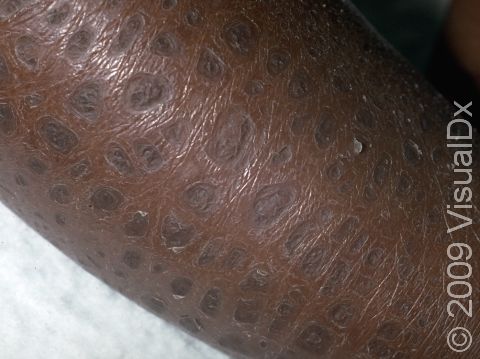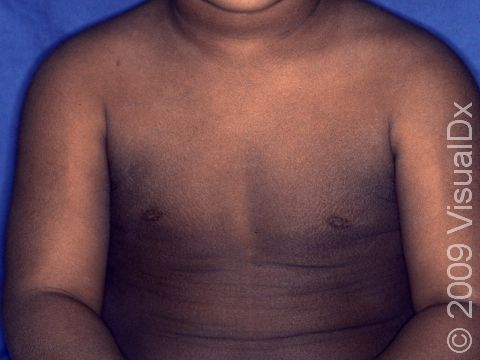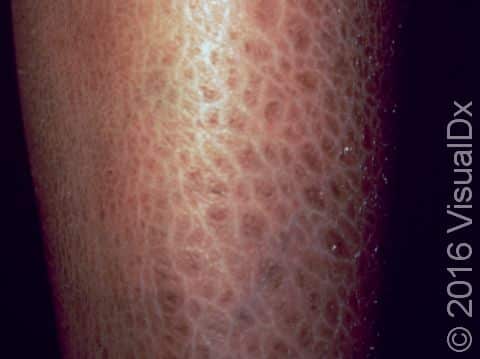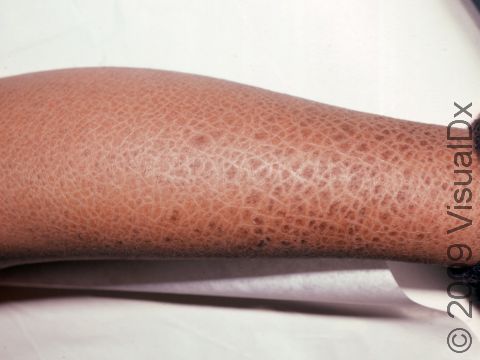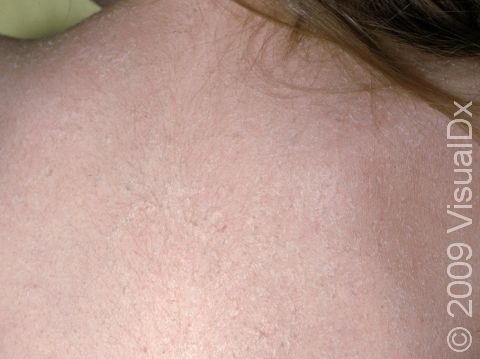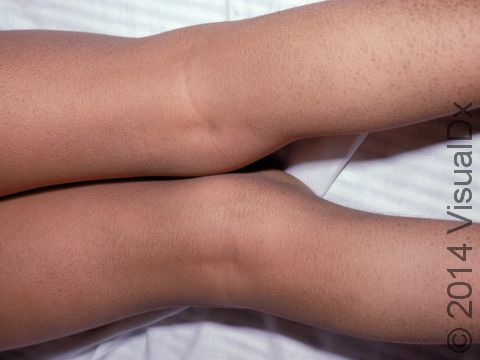Scaly Skin (Ichthyosis Vulgaris)
Ichthyosis vulgaris, also known as common ichthyosis or fish scale disease, is a skin condition resulting in scaly skin, especially on the arms and legs. Its name is derived from the Greek word meaning “fish.”
Ichthyosis vulgaris can be a trait passed on in families (hereditary) or it may develop later in life as a result of certain exposures (acquired). The hereditary type, also called congenital ichthyosis vulgaris, first appears in early childhood and accounts for more than 95% of cases of ichthyosis vulgaris. The acquired type usually develops in adulthood and results from an internal disease or the use of certain medications.
Who's At Risk?
Ichthyosis vulgaris is found in people of all races and of both sexes. Hereditary ichthyosis vulgaris is fairly common. As many as 1 in 250 children may have hereditary ichthyosis vulgaris. On the other hand, acquired ichthyosis vulgaris is rare and is found almost exclusively in adults.
In hereditary ichthyosis, at least one of the affected child’s parents usually had the same dry, scaly skin as a child. It is inherited in an autosomal dominant fashion, meaning that each child of an affected parent has a 50-50 chance of having hereditary ichthyosis vulgaris.
Signs & Symptoms
The most common locations for ichthyosis vulgaris include:
- Fronts of the legs (extensor surfaces of the legs)
- Backs of the arms (extensor surfaces of the arms)
- Scalp
- Back
- Forehead and cheeks, especially in younger children
The scales of ichthyosis vulgaris range in size from 1–10 mm and in color from white to gray to brown, with darker-skinned people often having darker scales. The legs are usually affected more than the arms. The creases on the palms of the hands and the soles of the feet are prominent and often crack during dry or cold weather. However, the scaling tends to improve in more humid or warmer weather.
The following areas tend to NOT be affected:
- Face
- Front of the neck
- Abdomen
- Folds in front of the elbows (flexural surfaces of the arms)
- Folds behind the knees (flexural surfaces of the legs)
Ichthyosis vulgaris tends to be itchy.
Self-Care Guidelines
Hereditary ichthyosis vulgaris tends to improve after puberty.
In addition, ichthyosis vulgaris should improve by restoring moisture (hydration) to the skin. Creams and ointments are better moisturizers than lotions, and they work best when applied just after your child’s bath, while the skin is still moist. The following over-the-counter products may be helpful:
- Preparations containing alpha-hydroxy acids such as glycolic acid or lactic acid
- Creams containing urea
- Over-the-counter cortisone cream (if the areas are itchy)
Any cracks in the skin should be treated immediately with a topical antibiotic ointment to prevent an infection.
Treatments
To treat the dry, scaly skin of ichthyosis vulgaris, the physician may recommend a topical cream or lotion containing:
- Prescription-strength alpha- or beta-hydroxy acids (glycolic acid, lactic acid, salicylic acid)
- Prescription-strength urea
- A retinoid medication such as tretinoin or tazarotene
- High concentrations of propylene glycol
For more severe, stubborn ichthyosis vulgaris, oral treatments may include isotretinoin, a very strong medication with many potential side effects, usually used in the treatment of severe, scarring acne.
The prognosis for a child with hereditary ichthyosis vulgaris is excellent, as most children improve after puberty.
Visit Urgency
If your child continues to have very dry, scaly skin despite twice daily application of an over-the-counter moisturizer, be sure to tell the doctor.
References
Bolognia, Jean L., ed. Dermatology, pp.775-781. New York: Mosby, 2003.
Freedberg, Irwin M., ed. Fitzpatrick’s Dermatology in General Medicine. 6th ed, pp.486, 482, 2353. New York: McGraw-Hill, 2003.
Last modified on August 16th, 2022 at 2:44 pm

Not sure what to look for?
Try our new Rash and Skin Condition Finder
